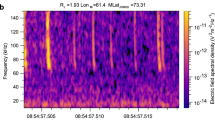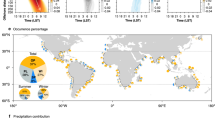Abstract
THERE seems to be a simple explanation of “An Unusual Rainbow” described by Mr. Low in NATURE of August 30. If the sea was sufficiently calm there, would be, from the point of view of the raindrops causing the rainbow, a real sun 7° above the horizon and also a mock sun 7° below it, caused by reflection. The primary and secondary bows caused by the latter as source would occupy exactly the positions indicated in the sketch with the appropriate colour arrangement. As the intensity and definition of the mock sun, good at grazing incidence, would fall off rapidly as the angle increased, only the lower part of the bows would be distinctly visible; this also is suggested in the sketch. The calmness of the sea is not specifically mentioned, but seems to be implied by the other weather conditions stated.
This is a preview of subscription content, access via your institution
Access options
Subscribe to this journal
Receive 51 print issues and online access
$199.00 per year
only $3.90 per issue
Buy this article
- Purchase on Springer Link
- Instant access to full article PDF
Prices may be subject to local taxes which are calculated during checkout
Similar content being viewed by others
Author information
Authors and Affiliations
Rights and permissions
About this article
Cite this article
ASTON, F. Unusual Rainbows. Nature 100, 5–6 (1917). https://doi.org/10.1038/100005d0
Issue Date:
DOI: https://doi.org/10.1038/100005d0
Comments
By submitting a comment you agree to abide by our Terms and Community Guidelines. If you find something abusive or that does not comply with our terms or guidelines please flag it as inappropriate.



